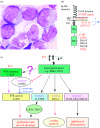Analysis of phenotype-genotype connection: the story of dissecting disease pathogenesis in genomic era in China, and beyond
- PMID: 17327209
- PMCID: PMC2435570
- DOI: 10.1098/rstb.2007.2033
Analysis of phenotype-genotype connection: the story of dissecting disease pathogenesis in genomic era in China, and beyond
Abstract
DNA is the ultimate depository of biological complexity. Thus, in order to understand life and gain insights into disease pathogenesis, genetic information embedded in the sequence of DNA base pairs comprising chromosomes should be deciphered. The stories of investigating the association between phenotype and genotype in China and other countries further demonstrate that genomics can serve as a probe for disease biology. We now know that in Mendelian disorders, one gene is not only a dictator of one phenotype but also a dictator of two or more distinct disorders. Dissecting genetic abnormalities of complex diseases, including diabetes, hypertension, mental diseases, coronary heart disease and cancer, may unravel the complicated networks and crosstalks, and help to simplify the complexity of the disease. The transcriptome and proteomic analysis for medicine not only deepen our understanding of disease pathogenesis, but also provide novel diagnostic and therapeutic strategies. Taken together, genomic research offers a new opportunity for determining how diseases occur, by taking advantage of experiments of nature and a growing array of sophisticated research tools to identify the molecular abnormalities underlying disease processes. We should be ready for the advent of genomic medicine, and put the genome into the doctors' bag, so that we can help patients to conquer diseases.
Figures






Similar articles
-
Genomic medicine and risk prediction across the disease spectrum.Crit Rev Clin Lab Sci. 2015;52(3):120-37. doi: 10.3109/10408363.2014.997930. Epub 2015 Jan 19. Crit Rev Clin Lab Sci. 2015. PMID: 25597499 Review.
-
Clinical application of microarray-based molecular cytogenetics: an emerging new era of genomic medicine.J Pediatr. 2009 Sep;155(3):311-7. doi: 10.1016/j.jpeds.2009.04.001. J Pediatr. 2009. PMID: 19732576 Review. No abstract available.
-
'Deep phenotyping': characterizing populations in the era of genomics and systems biology.Curr Opin Lipidol. 2008 Apr;19(2):151-7. doi: 10.1097/MOL.0b013e3282f73893. Curr Opin Lipidol. 2008. PMID: 18388695 Review.
-
Linking Genes to Cardiovascular Diseases: Gene Action and Gene-Environment Interactions.J Cardiovasc Transl Res. 2015 Dec;8(9):506-27. doi: 10.1007/s12265-015-9658-9. Epub 2015 Nov 6. J Cardiovasc Transl Res. 2015. PMID: 26545598 Free PMC article. Review.
-
Advances in translational bioinformatics facilitate revealing the landscape of complex disease mechanisms.BMC Bioinformatics. 2014;15 Suppl 17(Suppl 17):I1. doi: 10.1186/1471-2105-15-S17-I1. Epub 2014 Dec 16. BMC Bioinformatics. 2014. PMID: 25559210 Free PMC article.
References
-
- Altshuler D, Brooks L.D, Chakravarti A, Collins F.S, Daly M.J, Donnelly P. A haplotype map of the human genome. Nature. 2005;437:1299–1320. doi:10.1038/nature04226 - DOI - PMC - PubMed
-
- Bruzzone R, White T.W, Paul D.L. Connections with connexins: the molecular basis of direct intercellular signaling. Eur. J. Biochem. 1996;238:1–27. doi:10.1111/j.1432-1033.1996.0001q.x - DOI - PubMed
-
- Bu L, et al. Mutant DNA-binding domain of HSF4 is associated with autosomal dominant lamellar and Marner cataract. Nat. Genet. 2002;31:276–278. doi:10.1038/ng921 - DOI - PubMed
-
- Caulfield M, et al. MRC British Genetics of Hypertension Study. Genome-wide mapping of human loci for essential hypertension. Lancet. 2003;361:2118–2123. doi:10.1016/S0140-6736(03)13722-1 - DOI - PubMed
-
- Chen S.J, Chen Z, Chen A, Tong J.H, Dong S, Wang Z.Y, Waxman S, Zelent A. Occurrence of distinct PML-RAR-alpha fusion gene isoforms in patients with acute promyelocytic leukemia detected by reverse transcriptase/polymerase chain reaction. Oncogene. 1992;7:1223–1232. - PubMed
Publication types
MeSH terms
LinkOut - more resources
Full Text Sources

